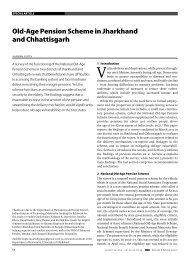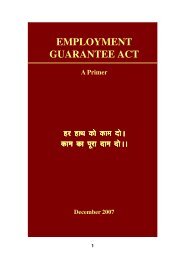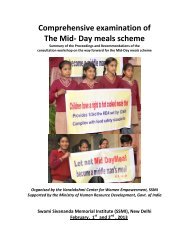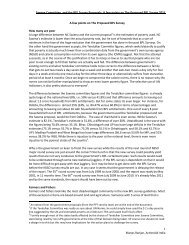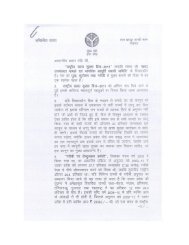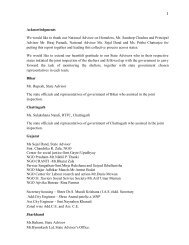NREGA: Opportunities and Challenges - Diksha
NREGA: Opportunities and Challenges - Diksha
NREGA: Opportunities and Challenges - Diksha
Create successful ePaper yourself
Turn your PDF publications into a flip-book with our unique Google optimized e-Paper software.
<strong>NREGA</strong>: OPPORTUNITIES AND CHALLENGESgains for villages that better utilised their l<strong>and</strong> <strong>and</strong> water resources.Why am I recounting all this? Simple: the National Rural Employment Guarantee Act (<strong>NREGA</strong>) is built on thesame premise. It even improves on past schemes by incorporating the need to invest in natural assetcreation (soil <strong>and</strong> water conservation); by making village level planning m<strong>and</strong>atory; <strong>and</strong> by making theelected panchayat (not just fractured departments) responsible for public works. But two years after thescheme’s launch, I must ask: do these improvements incorporate past lessons?Travelling in Rajasthan in peak summer, I found women working on the village 100-day scheme (as it isknown locally) in droves. Under a blistering sun they were digging the defunct village pond. The localengineer explained the scheme, formulated by the panchayat, was to desilt the structure <strong>and</strong> then build itswall. I saw each woman was digging what looked like a square. Why? The supervisor explained this was therequirement, based on a ‘scientific’ estimation of how much each person could dig daily—how many cubicfeet of earth could be moved. The square the women were digging was thistask rate, used then to calculate the amount of work done <strong>and</strong> so thewages. The women I spoke to explained this only meant they never knewhow much they would be paid at the end of the week or fortnight, for the taskdone would be individually calculated.I realized that in Delhi’s obsession to deal with inefficiency <strong>and</strong> corruption,the nature of the work was almost forgotten. Nobody could explain if thesquares dug each day would add to a tank that functioned. Nobody cared ifthe channels that brought the water to the tank were de-silted. Nobody evencared if the 100 days employment would lead to the work being completed.Fractured bureaucraciesforestdepartment,agriculture department orirrigation department- didnot lead to holistic planningat the village level.In another village, located close to the Sunderban tiger reserve, I saw arainwater channel built under <strong>NREGA</strong>; it had changed the village economy tothe extent that people do not depend on illegal fishing any more. The waterstructure provided them with irrigation for an extra crop. This was the real potential of the scheme. Excited,I asked if the panchayat had planned the water structure. No, came the answer. “Ifwe work under a panchayat-led programme, we do not get paid because the panchayat has to clear itspayment with the district officials, who in turn require detailed proof that the work has been done.” Theprocedures are complicated <strong>and</strong>, invariably, people are either not paid, or paid less. This developmentstructure was implemented through the forest department, which has authority to plan <strong>and</strong> execute work.The details, not the concept, of the <strong>NREGA</strong> need to be fixed. Urgently. For the God of ecological regeneration,too, is in the details.3



